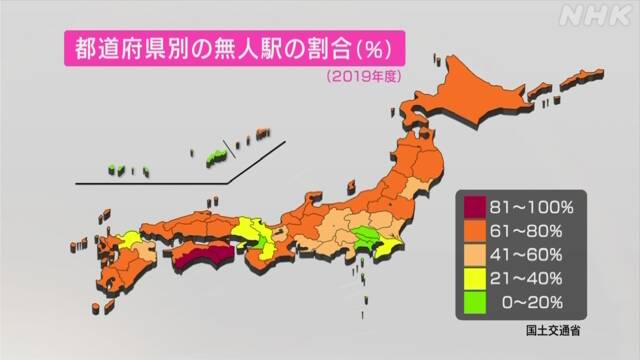“Unmanned” stations nationwide, even in the metropolitan area with many users, November 19th, 9:24
There are more than 4,500 "unmanned stations" that have no station staff all day long, which is close to half of all stations nationwide, and even in the metropolitan area where there are many users, the number of stations without station staff is increasing depending on the time of day.
As the performance of railway companies deteriorates due to the effects of the new coronavirus in addition to the declining population, the “unmanned” of stations may further progress nationwide.
According to the Ministry of Land, Infrastructure, Transport and Tourism, "unmanned stations" that have no station staff all day long have reached 4564 stations, which is 48.2% of the 9465 railway stations nationwide, as of the end of March.
Compared to the end of March 2002, 18 years ago, the total number of stations decreased by 49, while the number of "unmanned stations" increased by 444.
Looking at the percentage of "unmanned stations" by prefecture, the highest is
▼ Kochi prefecture with 93.5%,
followed by ▼ Tokushima prefecture with 81.6%,
▼ Nagasaki prefecture with 79.6%,
▼ Yamaguchi prefecture with 77.6%, etc. it has been,
will climb to 14 provinces to meet more than 70%.
In ascending order,
▼ routes are 0% in Okinawa prefecture with only monorail,
▼ 3% in Saitama prefecture,
▼ 9.9% in Tokyo,
▼ 16% in Kanagawa and Osaka prefectures, etc. It is
low in populous areas such as the Tokyo metropolitan area and Kansai.
“Unmanned” in the increasing time zone in the Greater Tokyo area
“Unmanned” is progressing even in highly populated areas.
In the metropolitan area, the number of stations without station staff is increasing depending on the time of day.
In JR East, the number of stations that do not have station staff at the counter is increasing year by year depending on the time of day, and now there are about 140 stations in Yamanashi and 1 metropolitan area in the Kanto region, and the counter is in the early morning or during the daytime when there are few users. Business is handled remotely from another location through the intercom.
It includes stations in the city center such as Shinanomachi Station and Sendagaya Station, which are close to the national stadium, and there are at least 24 stations within a range of approximately 30 km from Tokyo Station.
The target is stations that have many regular users who are accustomed to the station and have few troubles.
At Yono Honmachi Station in Saitama City, one of these stations, from March last year
▼
6:30 am
from the
first train,
▼ 9:30 am to 11:00 am,
▼ noon to 1:00 pm,
▼ 2:00 pm to 5 It takes 7 hours in total until the time, and the
station staff does not respond to the counter.
The number of station staff on duty has been reduced from two to one, which means that we need to reserve time for other tasks and breaks.
In the event of a safety-related situation such as the emergency stop button being pressed, or when wheelchair assistance is required, the station staff will respond even during breaks.
The background is that the number of railway users is expected to decrease in the future as the population declines, and JR East's Deputy General Manager Tsuyoshi Mori said, "With the declining birthrate and aging population, in the future It will be difficult to secure not only users but also employees. I think it is necessary to improve efficiency, secure resources, and use it for equipment maintenance. "
"Unmanned" raises concerns about safety
As the station becomes "unmanned," some people say that it will hinder safety and convenience.
Among them, there have been a series of voices in various places saying that people who use wheelchairs and people with disabilities in their eyes and ears have difficulty receiving assistance when getting on and off, and in Oita Prefecture this September, men and women living in wheelchairs 3 A person filed a lawsuit against JR Kyushu, saying that "unmanned stations violate freedom of movement."
One of the plaintiffs, Noriyuki Gotanda, who lives in Oita City, said, "I don't know who will help me immediately if I fall off the platform at an unmanned station. This time it was a trial, but it is possible. I want to create a place where we can talk with each other as long as possible. "
On the other hand, JR Kyushu is promoting the introduction of a surveillance system that can detect abnormalities by installing cameras at unmanned stations, and we are seeking understanding that safety will be higher than before.
Against this backdrop, the Ministry of Land, Infrastructure, Transport and Tourism launched a study group this month in which railway companies and organizations of persons with disabilities participate.
We plan to discuss specific measures and compile guidelines for railway companies around the summer of next year.
Expert Corona may be unmanned due to the scourge
Professor Kiyohito Utsunomiya of Kansai University, who specializes in transportation economics, said, "The big problem is what to do in the future where profits in metropolitan areas are not increasing due to the influence of the new coronavirus. It is inevitable to improve management efficiency. Then we have to reduce the number of station staff and services, "he said, pointing out that the corona disaster could further unmanned stations.
On top of that, "It may be an opportunity to rethink what the station should be. Since the station is a place where everyone can gather in the area, it is necessary to consider issues such as ensuring safety and convenience in the entire area in order to make good use of it." I'm talking to you.

